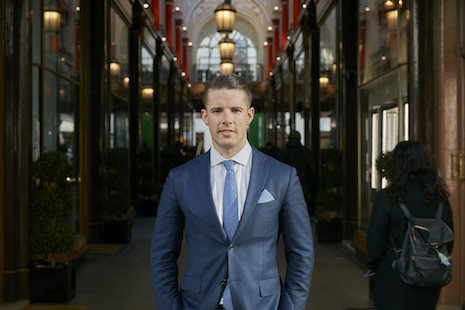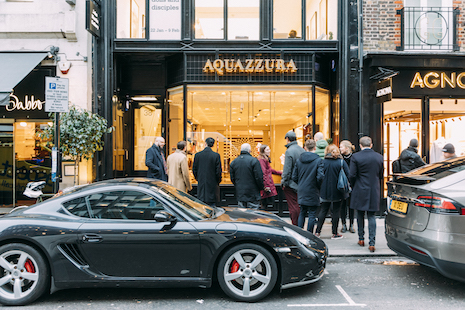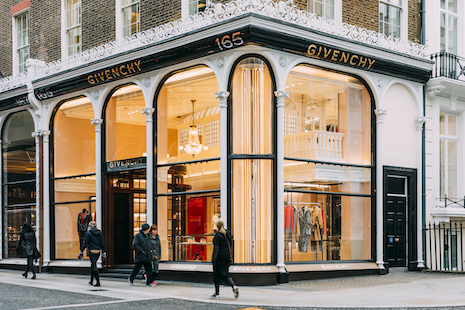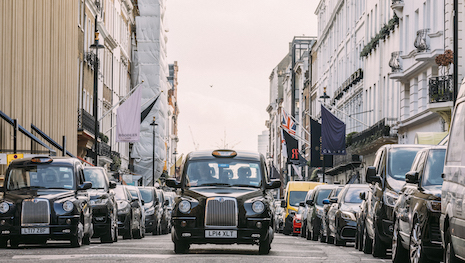As bricks-and-mortar shopping becomes more about the experience, Albemarle Street in London is looking to further position itself as a luxury retail destination by curating a balance of stores, dining, cultural and hospitality establishments.
With more than seven store openings in the last year, the avenue is attracting brands that are thinking outside the box of the traditional shopping thoroughfares in the city. Albemarle Street is also responding to changes in shopping behavior with a retail mix the includes both heritage luxury houses and more up-and-coming labels.
"We are proud that Albemarle Street is home to a blend of classic and contemporary brands," said Matt Farrell, managing director of The Albemarle Estate. "It is rare for a high-end destination to offer both iconic and classic brands such as Cartier alongside the hottest fashion brands in the industry, for example Self-Portrait.
"We consider Albemarle Street a timeless luxury lifestyle offering which continues to offer the very best of the luxury industry for both established and new brands," he said.
In this Q&A, Mr. Farrell discusses how London retail is evolving, the changes on Albemarle Street and his plans for the estate. Here is the dialogue:
Could you tell me about the history of Albemarle Street?
The street was built by a syndicate of developers headed by Sir Thomas Bond, [who] also created Old Bond St, Dover St and Stafford Street.
The syndicate purchased Piccadilly mansion, Clarendon House from Christopher Monck, 2nd Duke of Albemarle in 1684, London’s then-grandest private residence. The house was demolished, and the syndicate proceeded to develop the area.
During the 18th century Bond Street was renowned throughout London for its luxury retail offering, and in 1879 it expanded into the Royal Arcade, forming a crucial link with Albemarle Street and its more niche luxury brands.
Albemarle Street was the first one-way street in London. The decision was taken after a series of lectures at the Royal Institution caused long traffic jams because of the queues formed by horse-drawn carriages bringing in the eager audience. Albemarle Street was made a one-way street to avoid further incidents of such congestion.
Lord Byron’s publisher John Murray was based on Albemarle Street, and Oscar Wilde regularly stopped by as a member of the Albemarle Club.

Matt Farrell. Image courtesy of Albemarle Street
How has Albemarle Street evolved in recent years?
Over the past few years, we have been responsible for the careful curation and regeneration of Albemarle Street, transforming it into one of Mayfair’s leading luxury destinations. Over the past 18 months, Albemarle Street has continued to cement its status as a vibrant luxury lifestyle hub having welcomed several high-profile openings to its dynamic portfolio, including Givenchy, Cartier, Robin Birley’s new private members club Oswald’s, luxurious all-day restaurant Isabel and the celebrity-favorite Self-Portrait.
What trends are you seeing in terms of luxury brands’ retail location choices in London?
Time is a more precious commodity than money, and places need to be destinations in their own right to offer a memorable experience beyond pure retailing.
London heads the luxury rankings in terms of luxury brand presence, marginally ahead of Hong Kong in second position. London’s edge may be due to its heritage and strong tourism as well as the strength of locations such as the prestigious Mayfair district, known as one of London’s most prime spots for ultra high-end shopping.
Nestled within the heart of the Mayfair district, Albemarle Street has become a melting pot for the flagship stores of U.K. and international brands including Alexander Wang, Aquazzura, Self Portrait and Casadei.
As a result of rising rents and consumers looking for more tailored retail experiences, iconic and timeless brands are breaking away from their original locations on the world’s most famous shopping streets, into more innovative and emerging neighboring locations.
This is evident more than ever on Albemarle Street, where a revival is happening. The street welcomed over seven new brands last year alone, with more to follow in the coming months, and three of these are world-renowned Bond Street brands which have broken onto Albemarle Street with additional store frontages.

Aquazzura boutique on Albemarle Street. Image courtesy of Albemarle Street, photo by Joas Souza
Why should brands consider opening an outpost on Albemarle Street?
A recent retail report highlights that ‘many retailers regard London as the entry point to Europe.’ This is certainly true on Albemarle Street, given the various big brands which have selected the street for their first U.K. flagship.
Albemarle Street is its own micro-destination with restaurants, hospitality, health and wellbeing and culture. It is very rare for one street to encompass all these aspects, which are often more typical of a whole district or city.
The street’s array of timeless and contemporary brands is especially appealing as it offers a boutique shopping and personal service, which is not found in a department store, providing consumers with an above and beyond shopper experience.
What are some of the notable recent openings on the street?
The VIP luxury shopping lounge Global Blue, which opened in the fourth quarter of 2018, is one of the most significant openings on the street over the past few months. As the first ever VIP shopping and tax refund lounge, we are really pleased with its arrival to the street, which specifically brings UHNW global visitors to Albemarle Street.
This month we also announced our expansion into the neighboring Stafford Street, with the arrival of Natasha Zinko’s new store, which will open this summer.
In what ways are you working to differentiate Albemarle Street from neighboring shopping thoroughfares?
We are delivering a unique choice to visitors – bringing together a blend of the best of high-end living and lifestyle – with the right calibre of brands. Our restaurants are a key feature and were specifically selected to provide our Albemarle Street customers with the perfect place to enjoy a stop off during shopping.
How do you decide which retailers will be a good fit for the corridor? How are you planning the retail mix?
The street should see consumers able to spend a day totally lost in luxury, so we look for brands that will fit this brief and appeal to the Albemarle Street visitor.
This requires a mix of shops and places where people can have lunch and coffee as well as relax. For example, the addition of Isabel Mayfair, the super cool all-day restaurant and bar which sits well amongst the luxury fashion brands and galleries and provides a stylish eatery to meet with clients or catch up with friends.
As Albemarle Street seeks to innovate and attract forward-thinking brands, how is it balancing newness with its own heritage?
We are proud that Albemarle Street is home to a blend of classic and contemporary brands. It is rare for a high-end destination to offer both iconic and classic brands such as Cartier alongside the hottest fashion brands in the industry, for example Self-Portrait.
We consider Albemarle Street a timeless luxury lifestyle offering which continues to offer the very best of the luxury industry for both established and new brands.

Givenchy boutique on Albemarle Street. Image courtesy of Albemarle Street, photo by Joas Souza
From your perspective, what is the outlook for London retail?
Innovations in tech are increasingly being introduced across the luxury retail sector within high-end brands and stores, and this is emerging on Albemarle Street. The Global Blue lounge uses unique VR technology to offer an immersive experience for consumers.
I think we will continue to experience this rise in technology across fashion stores as brands continue to offer one-off in-store experiences going beyond a standard store visit.
What are your goals for Albemarle Street, in both the short and long term?
As well as welcoming further luxury lifestyle eateries and brands to the street, we hope to commence our plans for the public realm in the next year or so, widening the pavements and reducing traffic to make it a more pleasant place to be.
Our ambition is to create a vibrant lifestyle destination that extends beyond Albemarle Street into the neighboring Stafford Street, and we are excited to reveal future signings in the coming months. We also look forward to welcoming the LVMH Cheval Blanc hotel to the street, which will bring a new wave of visitors to Albemarle Street.
{"ct":"xgyzCmSEm8RlHr3cPdzeDan\/Tz24J0p0fLWhp8VK8uiuUC4ol3W54QlGykk2QphKJ7PlOq\/QB1r\/zm\/bG9VjxccIzYKPfIRLCII9PJTAB+dnLwLkO\/pVnV8gf47OxMS6f6K1QwGAKsSDGCbnkLotP6CiN19w\/tkBGyq4uLD5E4l9sHDBkx9mXICQJ10Fi7iF5NnouD8Z876kvDnr0A2ZdsG0wtfxqrkmAbJFak3eJ3Rqr9Q5N+JO3pkbT310xv9sUEFlzkNC+uekWpByf9jgmzE6lMWzGKO604zRqO2m0zKrUFztQIvq8ht3ApREOmpAPTmevTXSeqAuCGZNnbWXsB5dmdHqPvijtv\/7f2XRUxFAYMuOnzDsXOcKn4SZ9TsEGlvx3Jix00oq5Vz8vt2UutIivZk9+35SPfeKU2YQtXZsa6eM+WfFSMn50HxKGJHjAJBUPJN9K9dkLCBWNZkvPU3BPV6ATcTipob13RbIGNilKx22HhzSpJftKRMFV2JP4\/f+PdA7etSjaVZCdZcoNKRzjS5Z1afY0hJhyNku3z6gX43+lzNTfdtWSkouE43b6UvqVHOq9L8WIKJpIuVSqnbE4xL7pmTF62QhfH8ikfCwwjKw7jtNboltOcscImscvrkbuROufyM9UiiXT90F2TzqjMXRLI07nrATZvlt9cjfYainmyCzKguvnnklPAs0ux1fULqFRSFFpAYz3uRfI7CINyUj6lqsJiHWpkzi0Vn3p\/s6+iM5CHCJ\/AAjQoXsB+DojB3QB52hscFXr7OJVyyZdNjuToj9vTLMXdVAcB2hAbBGxrV2E51oV6jTUE3+agKqFu5aN+YraysPGQCy+sVFy+hIJj\/N74cwN3J4XUtDPMKe3WH1NvvQeJalJ8xprIbRKwq6gHXPP0I4\/3gCBrTf\/XGkAp6ftcal84+ybGpHqtOYcWzV4vPL64wr2hFqvPCjPDluEunnYPAACVt5xDZA09sQQ73T85McKQ9gzYFaQ1E7REvZbr1qGIbG2oGwbXeOFMh40jUaK5fS\/yl5UL\/hr\/FS1o19O8+L1C2j7AnJB3YKMGqUsz+S1Y9r79lUL37drJJlpvFfNuoKHop6IMydPE340s1As23rYEcmEY5lhY+Gs6r9nKsfGwR30CyyKv\/EadBUZIrT9bVR7qsuce1DgmPY0qUjnxJw+mx0ganWFRfhCbigelgPI27Fj4VofVWViu003fl33CCRNK9jA77tmLOgwCX2nLrO8Y8iZdCO0HyWVY0cbCQQdRe98LpodzxpLhgnaOaA\/iAp9WV8IEyPoAk4YKcxyJV93zynXN6s4PJPvJWeLQHLqxV5Tm7fUE55SC\/Ni3w9\/ov9PNqD4LMeNovOCL13YfcS87Va1Fo4Lgeo4d8hJodN+s8El79qB88rhAKI9lyhxliJ0ZV1ExzvxwD9oSud+iAUIh4\/zdnP6+\/bqiYJV1MIgWox+kiK+IcG3R4c1i\/jI6V02g\/syMIaq3Xa8VURAYrric\/uWBzkJIf6KyQLRCaceBzN5WXx2EhYPH4\/+33vKTYbz6atKpsPB\/jruK4XuzJ90HoN8Ib1+KuA1wib+2Jl73b5kT642F4UT5M9lFGEHEmU+eRYX6+lTKG9AUt55loWGzETaGo21LoZqKcJeFJBn50YJBOYCI5+Gxj9\/7kQnTP5F6qkPxs+m9IClxJ2h94\/wi6DpsW29E7YuRYj7zg5H+TXhUi0ZUc0wb0FtayCtyCww6ZiWjmaiFe3E1J5h3Lerh9sEqv3ATpHNRTKUlDBN7S6jMjb3aoTgEOb+1O3YU2H94SbAY+si9pTNMzbwUIlySGxKrurgNHNejJ9Y6M48sajiQ88zpPO5qLofinO9FTxm3mNY+uvoGNMAm3A1g6FIQJPPwWg9a0ZXpYhaxDoN1qa7NK3bxs0pUpxZM6YOwR7miAt9hjtd\/zAePICrBq3p9cVg+CiuA+KsVnW9r35wh5zAh2aiTN0CHUK1Fhb30XXKph95HASgHQN3VWuy65sH25u6CK+LwrcliID5jFQUCe5hGC451zYoXUtcZvhz+U\/e19buEAyJN62+fT3BFT7uDaBGldGq3wiP056g86+dsLupLUtIOw\/PTWIOIm1\/89mOgcgVmgdReTk0q0YpMniFUPfl6\/RNqCQkFlho7tBwYvIje+OmtrTlov+sCef984vsl2KRbcZKSyi+vWLod6H24Efb3qbT1eFQzOBKlSEOfbm5BWhxnPIEl+Hbs23KPk7EEE7OvOJlLeCNecxG7R2b\/DtRVR4CRKWi0w6a7E5HzyBthtqy7YHY+Cd8lDcdotIQm\/SAGAbnFH3jSaxJff6nl7GQzqSCoTJT2mkvDNmre3HkAwyW3QLjZaFaSqKY7QAyP50X\/LVObw9nMnZdaiEad5wY93s8jsgxSNLOTDpq9AE+9rQ0QIJRST1+RwejuwgUVFjf1nBMaISnV0i\/QUDCMCdHnOytqAasPRXIQt2cDEJ946exTBH77IRvI9ll5UgAZvZhYlWMKs3xMOyk9M7chxWg6oo\/PLnV2F+qlVkHfVV9k531hlDPHJstwNrhkGOhaZ4DqlJi5m1VaqTJbtZItK8bLbTvM2qiibVTYCKCF0CY7Q3NL8hlajcA15WF\/ms6tboGekBKfyNfHMkpxJtIu4029vkc0pREC9Oo18Ttir7KMs4mv2hZESYELhBCKgPvxhgtPAmjS5C1rl2E2dAdlKDz673RVmvmsQoCuRSUhK8CHRi9emwQJPNcpugh9Wab6bBSLoArrKlY3xdDyBGSPiWWBm\/qfZb273eGUddUA\/FiY5MgsqPS4nzZuUUEA8DYWuLgnKQHwzbTaGvjoXQ2qTzmjUG5O6bzu9a2ivfdlUYZNYI\/LEpl2ystEKebbN\/3jYHREMk2+R2mp4mJlpcDmABy0+E8xW+HNRpPyWp4paZxBUr++D\/YP2LeuWa3C5Q8PTWx8MSEhp9fHnYFhIDZ9OKY4WVAftKdqC4FTIyK4WIdtxRInc80M1M7rg6X3izk8MnCKtiKRwXsgAN7xfzaP5mIfvx+blVgJbDQaAq93r5hpf0sgrQvOAnXGU4duj\/Nr2vIE3qLdcupGpQBEB8isk8yCQw3RNHar\/LP2WL2t+Fich60SRljnu\/EvwNKN1dDvxMHwxFAj7TinZ2qgVyP\/NJC4kwOPpNOBthmbf9GE3C1KjcpGyW3wYkFtKpVSrIW44r6uiuQ4TxnOAQU7pSUstyj+Iu5QnjFSzPXi4+vqbwArSXXDmz2dD3dk9XxNSKICG2LMd8p0kU7y1cxMS9e8Ijkj9p29xfmdONcNxZ14rQGBlvIiBpEyNLhU5mW\/BhzcvfcAXgPobnqeKLMt3ChdyYH\/NY+rMlnvq0wGUJdGvG\/7FPs56z4ulN7ueYWjONHzzj\/CD+1h+fvXjktHDd95HjPCyc+BzowaeefQDc6CL\/ukqkmnSKHBQYE\/OwjOtfIh2Au+Xm6IAlPu12COjU\/QWt3Twn2YN6Liy2PI0hNYOffTZ1a+jYYIcz6hIxY1csz9SIYcNdnKETGy7jmBjIF3DVHPVUtOW4bdaO2y2q8JOCbZUoGm3UbAvg1ysvlSKyvKj+nf6z8hMNvx6nFlNf\/2+TneKxy2yiUpnvxUtq32aRKqfudrgh1uuki87qsJ9DFeqNM0v7NKpDsvC1hSn1sxE7DNtTUEG\/12MqUosRIKaw1\/7rW7C9B7yriEhik2RqmvCliyNMJNinbRPGfTvgUfhiAC7eO9wBbH1vsthyNtY0JpFLVq7txN3nTebjIWlQmornozuet2gYWDOWwFOn+5YkYpuDxlenI43MJbqhBd6jsTVogG63TwzGuf\/d9yZHZz1RZbsnqihIXjgg26h70sXrTQKQKNnDEw0GbiOS6SaqCwHNhoOTD5aKbBjdyMPYQnqCR59eFIlOmAwtSVNfDFyfdBVDXwydeG9VafXUyYsrKhXa9+rC+iGl93hcl76H2XXzlcQ\/qgoida\/mXuRuEvRhMB4vqpn61YL9mUCEV3AVyPFy7GxB+vT2UW5vTeAaJc3UxOvAbc3GMmcg+COb8B9DR1\/5W8ItzsvH2H97i5P4OFP7XqbNIPoBe95waFIty4T8Knfunfwnhrv\/JcgZt2cSITl3LzY+bJfndicefMnOci3V5YgHH+HJTyKTXpROZPCipR9j7zvf8F2zokZDXiDMD\/yA2qzVlQJZn\/RYMTtWB7nEAyT0vK9N1QaOFqZcRFwI6y3QC0v\/\/Zd4t8oPr1mIbqeRN8pFhtZvM6l5YET5sIcKaS02HPdNnMpSDKXSw8wWDHntVoohBa\/T8us8u1uijT3XCudqV3yqNtsEY8MwlyaWL7zpPIjZjXJz\/Lyepiqv4QQbfiPTkFzjxLXERdHRuvSeFPeKKNWSCQG0lpydktq7Y\/RuCDJlkIXZ\/2oU5xXTLZloIH76GtmKRAU7CYodGAIiAA1Pt40c8Scz+gNPEXgI0E+Vi5xJl9JNzmRcvYuHL0P+MFqXc9e3J6bPGUpshrokRQCyGDlGr7PoKqZ6fKnnp7BQ0jWl6bc2om8sN5iPzfqkg7yFpQv+5DM8ZCgDsOYKAuxVjybY437I\/fdS1s6EG0m08AtEE70nkz7xtS4tvY+4MhUi+4Mkb+swkW2wIBYHHycH8xr1fhRzlrKdCkDvGWLdTR4z7hKdGHt3TUv48Evu5TcWFBwd8PY7NuYCbV7X96vHIz9udTO5SOw6aYpRP7XSjZ30jxuAuUqO2D3WwXJ46c6pGWMa6Ac96MFpZwjJwDI6ISBFuzFU+gZZoWSLSsZtfLWneXtYJOa66HbWD3VMZsqRcSgkleVp+U4DaYl9xUNacNF446X7quDSynHPTjyKkdIWgzjc96oG82OCj2MGCZ1t9roHfRbEkzVRX0uspJ8ZvhEiRByOYYNE3Jwz4C+qctIWE1zZfyZqf9P29ulEOSKIkKt1e0x841cuoO1DXW2igUVxd\/UzL3fBd5DSFdiPex2ASXRreaFrjpBv2V0yMbRoPVMt0jmowRKP9oGMcf3lWJhhuK8Rk41sLL9Q2jVlW2LBGLSgFuwq6qCTg7+IWHH8uNj4KBHKmzksT0lO9GZ9AnZFs3CiBG2lzQSFYhMWAB8QhkKVDj6DFJKZ4\/SbZNPqQGygZx7CgLAePpNqlrotDOI4pRlOwaRY5uiTnZH5U\/pHgRe3QeTSxlg+pZ0943sIpWbMRwfmd8FzSmPejso0IBbek1ds7bY7G6W0yvZ4wGmd7V4\/iJY7VlqIRZo6sDCHkSOoUHm1JHF6jyr090cGAd1Vyu3R7ZNe+Pfa69XmFxaPtM2HrFyd\/pKTSsF5KIAjFA0mWTU9EZAYg5EE\/L4j88t9GH1\/C\/4sn53mqnSkOabtjhTGOVarRxHr6tbuUkn4o1O9Vg9jMO2GDZTaw0xM+b1WyDfKNdR\/bBRC0Cf8xT9d+YvnyZENfyIKFOt8sONRFajfpngrJ2DGYJe9RgozX2VPy4ODHwFtvF7rNO3EmKh+lUJYY1P1eyr3qXMt5hRo2sSlX718\/\/S6XKZ\/orUkoENhyeCQR\/EEOlXblLI2XP8YZbBPug+UInppzlMt4hfxJSZK33AvvMkw5WGcU+tF+eUcMN6M89lSEiXQeA24lNCsotRhiMHA0gyL6+ScdgYvk+UKA4AsgeA1sW+gAaAYS3gosItBet6MGVASg6PgboZaczrWaSI3ZYtxE1cNtqGccZEeB7W5udVDToDRb1489gpqq8rZF1otp9k89djj2fZeHXHmNFIP9lLbd+gtvbvyDvgbkRrgasSPeuALHzIv08P2Lt4iphj3FCOEI+\/Qvp\/5zc+clS\/CUd3aLAvDbOQLzjvI0S4SwyCm\/zWJiXVQX4vOU1VW87hIw5XcemB6NPtD2UIjqjwm3Bc+8SXgGs9YElwfhsuIZTuyVTtm+CZFXj8Q2krauKJ374FnAylFAnwfp5GCS45jORvKXraPJuIA6z\/AkcHdL+OtNcQK9Ed2R8LjoyDdLA988jnNXDrufdcnKjv349+XJuu5gzXSW0ivc+Zob0BMXSZGW2XtcJ0mkgyhhy09MVyr5VJbBRYjZrtWQB3lEyzLZAyACF+TyokD8gDFIoZUyfDRWxMs2Z2HdOPPyv7tPl1+v4dgWEF\/38U2iEAGmJmWiQ\/VrsxewsJOYYOsi09u+kM7qYlbdioG7qf94rkl7m\/picvueZxOxIDdx1XSDMFEngvlpOMwwtlmBs+wQ0595VyE9brdMqNpWnR9tzxaVNZpkIO+HNPUT\/hCOffgzrz3AdDtGkVSmJDM1AXebzkODh6XvvUHK8wqoDdim32etLipkcYMQh0TJSe+1txoqHXLPKHLSUap\/1NlgbSaxWwc7SURTLbscZPTn6l+6NOSeUX3neQHYGr\/7pG0CrwPxo0C0o\/vTvRS0u8oPScHNaw52rxcaV7FtdzD7idk5WgqPXZgZoIboV3wl72wO9hayCuSMUIUIaEMdPYR6H+qaJ4o1bgG905jFv0jguO6HPNqDTdyLvwqOiy6GA3f++SVk6yam8vTh8QbH+9AMEhRfsuyqdsXETesiqWKDl5hMTXS+hkQw7DwSzAOovjgGPR\/j0VbUY68KafWVVWby4w12pHXnc+pwbvQjn7PfZuxE8m\/nqA7IgydH062EsuJduRlbE+gf\/YlBh2jL\/WrmwDVaaBAOcSUA65P8dwS5tbvsbZG7Yc+y7RLwk0P7m9+eZJWSyKNqR8kDOFGPrL6KMAptS0d0KMddfx6J4RzF52rBObY9X58fonpZaQ2A92+zs67pLsXCi34tPEWQltd6IiCF83HJwyxKMb5NqmwzKTCaWbEw4fTYNXpPtcyHQdXH8g\/JSlnyZuuPOv0ClHG94wkjFL8dQvnuw3YF2su0ijl2piTMywSTrfaX7IBPd7ZsHiSuQ8UbXeqW1\/tcmX27vzUvuBn3W85jhtQpcBgVgicT77Qmnr2Nyw\/rDMoGsBrSkFAohc\/C2OpZDN\/b7gaowN6zojUG5UrbIY7O5EktR5isrOPYESLYJw1aE7bMqKCPmbIbksPE7UzQWHOT7my20bXYZLSSytCe2t\/Oy8+meV9vnCSQBfrlF6UA94sSB\/1ONLjXXyF2fCDBbSZMbAVbRMDR48\/O6Mpn7iADm3Zfo+TYxTs2yvnXULo\/aey\/+f+eTSM070GWRFB6zC9Nb4r+c1Xw62dux1u7AJhD9ZTlKJtbRdRScaEZEu\/7p8n9GObJj8ij39IZh4r0i8WiCNWclt3UIddZ0p5+uWW9FY7wxpcWMHGTkvKwxBUZF0YwEFAXok+jmGNDNl6AkOz+Gh7bVPfATGnTLK7WenZVDz16EqzRydUJ+zZvDLtAGRopxSwfxu1VLA1jGYV7tjsC6eWH6ZVRdLwQI5MfSSy\/lAwAG1UkG9I67tOUPodOM85Wf48B6vwv3X7X2D5OIfXg+5pgncII9K0IsINzQHmiPmfvzz2K0lkR1+KRFc5uUYvNN2QNp1LZ\/IOXmKxViJA9P79Qho\/q1HG67P1z2ffAwVoP\/8OXy4WKiCrMGhngYsFVcMMa80nh7I6Fw6+aL1MPaMy0q1M5aIvB87UFvcxVRAHNZKvnzEqOnHxT\/59tOSSeBuviOnq3rC6\/4l7ikQixMllIBS20nCNbQONPHLB1KlhPrg+kMyxvYlJWlsJ4hW2e8hVMAoNNDtL3QpQKivzTDQmX1I\/8Qkl7SiDYx0cx04gv7wSKl9v9teUa4tWIX5rDv57i81ciZQlcgFFztroGhtDDvQdtX0y3D69lkcRoUSP6egtidVif19mm64c\/Ds47\/3NxrDj348fhM5kjMa6MdVP\/UzFNJcyCJM1kwybvVs1joPJS6DFSSwZ5VffapHycMU22aIsfy91S5KgWCa1gV9JWJ5KefMMQvT+M3c6Hb44amSHRTMDRo3tIzPnXiaUwTrmkYe+q498P8IXRwLw6FHOfZ\/Jzf\/VaQS1UssiE0Jcsc1ys7z8CTRTZLRxXw6N9VOflEwIbWE8\/qx7bUmNH1ipvScsWVffPqhjBLVYKXexFJ+7Bv4v2d8\/1mxbvXPb0zE9J+8O+tR6sdqF9xr1DLpLtPwVsY0548KRa7tQia4saGSsHj3Yiy\/kI10Wfbe70lrU0zAylzDTRNzakusPlVgOop9ZIWkA+fVnc6zvnxaXnIdG\/lh+La1k7feFDBml1Ial1ih\/rmEzYCGSHOL62IU7MmPhsJz45nsapcpo2QtNS7TdLo0\/OCISdTs3SPQpqWMo2zcnjAp8rIUBiUNiy5KD9DeAZhzm5RizY0GJIFJgHVl1TJXcnvWAF9RASjUWwCeE5uRydjbIGUq8S\/O\/cFZDt4wpSW5a1boibZ5KgPlHD7RoVyKmH+HKFcPrzp9nMFMn8Pfp\/Pr1Yg+h+JQ+duGFmj5u1Dai5O5U+dE2KYUQF6cOYT1+q0txoWGHzXHIjEPd8IhcSV7BwjA006NhYvfTeppgV3h5qpD06m1OmkJHKFCV2tFZhXtdJ3x1XIOwEML\/9rX5\/sKKUJWXbPPXLsMiKbDKyxdU\/noER5V2FhMqDpqn4Y7QMW6Y3W9IvL3UYKR8dDyIXp5JAGzVswRZrYRkB5hzbVtkCqbsd5csmE1tiLAqDai7YgsBl8HxDLV0x\/ZXKROSpmhltU79\/UBcdI9P3uBit9LIsCpk0cgj8hp2D95J1LoAdztlCVZ+uvlxXxUqwNEAt8fFYZtTQ5sI4ZTsyKGPIRM\/\/0TYtoQK5VqeMEV9g5oQa0XLZ55I7r28Wx+jo\/DpCu7pUHEtkoghqzMwk18VSnGelujdO4pdnkY+YYNcD+FeDWKMtIWjsVsvzpBMWkciJzZwosy9VZ92ruZ+CTTzyCVEjZyRylq819\/NWaSc9W3cJXz12dwLYWqmdRz1RtstyLShIuxcn29pEg6qqnFhBORAEj9NcHX7nc+evrsSZeqB4fUDABiQtRU5O1JRt9efzdZteDLBQ7wb9STVAfbgbZg2mwT3owLb\/GJBVdeJA+nlZhz5DInithYwbY4AQkz0\/qSXCp8voOdtW7iJI6Zocbl1tnkekshC8skhelzkqwKsEzzs50JnWwrFZEMpuHc+uqVN1u+gybuFQW5CgmgusvgoLy1RKLi8Ef81SAz1hsNKedxiGFF+aYa\/Os2BJsW\/++LpWrOh7IJNpak06WLR0O\/HEPGAIynMRzW0fUN9sP98EU7Qy7dwSNRuhpeQE6FITsXajLKF5YGTJnPTOVAc4TSC8ZI0cs7paBHnFSN9OThCkjBZRu8VogRzqIqh8PMzi+mOO7GQIhi0SfJ5IZAcxZyxFw54oHfCE+Uol3R+8O7ONc0Hq2p2GsdIcvNMVSK+za51FshGB1CQctYN9M2xB7Ik\/JM0lA5ALqaMQV7QJKbLt0QGII7oPg5BpdVVe8XycoKhNbyet9zcsetJvNmgwNImMDOfuj8FNfioqfJ5LSTv58oHMW6LYZEBZ4kILn9XpWyBwnzLPSnpU0C\/JZJW6ZTxtkEeF+IdY2LB6MUy\/GHfeUuCfDiBDW+Shou1CfZNWTMmbJsgwHVXIbU0DeWF0go3aO5gHLdu5MYzUjcocjQGgwkyq5kIpZ9NxxIxJwj3FH3dni9wL8si2iutj+aFGQlLBagTKL3Mg89fdNCA\/0mPYhU48vIyERj4cvsU8V4B5uZzJTvlBplEGT3V0lvg1AGrEYtCt\/AvgCATWp5cbT8btE7ryJMd\/y994Y5oAJXiyAduuBzX7UNo0bxrbIGvlsyugb1HPeBBymI+LbZ0\/1fHtJEUrjznSIZPRUnziMD+tg\/ee\/b8WuWQm8LIvDde2XikxII3O+BwvC7eIzHuqRSQP8Uzk3j+cWp4JIVeI0W8S1futAOhzelbvVuZ9YWD7Ly4DPqU3NNdn2dJhlxmDx7YYZS2mqo6jQoslsdsJLEB0dEiQEYKcjhQjHCL7Lv3BmLkJbaE+4wTiesMF5eEsxzD72S2L+CW\/+e8yWmg\/NhXnd8GGCnJf6MuydlS9+9eHEtKQzJPih2mjs1xGImuREGHignFenLQFE7f4nYSV+jwRS7QBs0JGf7gsKoj96olnZpGRX4ASrF0z\/0fytti1fBVk2U6sePb9FcwvvaksRWxS+SrcP1NjtitGZHVuqPm7oSUoVTqYw\/s1QSVyHAydQAbq\/6s6hWonalJJAFKf18xB0CCZedHbn6jd+e1glQgcVgQ5TiFvV5V+w6W+cRLJjWSFEkqv5\/3Ob\/Xtx2aGwU3N6thnFXVGV\/D4DEv7gDYxEGzqAGhTVr7B47YdfSuz9n8\/r4fE851nhLGpRChSoYxRCQ3ZMjZpz9CF16zM4RrsyH3eQsn1rG4utARhjHnog1GDUoOMjN3ppE6Wpx3CEjO6gKLPeoQC\/bwFVE68vqMMd6UgIT4piB+f71S8N3AfyW+UtkAHNc0dJInp1Ebgamy\/wEpGIB5IFdhKtwCFMC7L7LHDtYqdsWnJsAafPcA7mlHpcl+pGdYqfP1oj8KQvzUUEUB8Sz9BHCkd4wjxvsSBwy5xwbyphke0nHeINT9Ug\/TpBhLU5AN2ot9zHi3eviJSQi7q32LGRkYwhN3ZaFPbZPEZ02FS7X58Fy\/QrA0x6\/IKoRgkDh\/MAGcCWw7V3oMW3Zrx7JUvFLnfNQrfR10YI6LpZiFxkkAdPTiervlKu3JUKpejr2CiBIDaM7qBQ\/aXW7auNMgwcsXekdmYUkciQMn9sPUgNDiXEoCMb8iiMNqTl+L8T8hBC8gAM5BkPLby4RffQMxYApipazWX5D4HxtgYPnaWTaPcMA0yqePuCv7XPAnZr\/XOctqIDT00VtqE4OHZm1iC5r66l\/S6y271a2iV3bjJk4SE1DALSX\/ghBr+NJoPfPu4MxaB9uW147i9tWiFaxTzk7tTbQeRL0VKw5DQmmEBRx7ZLtPfshjDxp5oQ3m\/pyiomue4MZG\/RgWQCqW+Wr5RdmnJ7pGOmewEz8eQfSzZu7aXYxWf2wfLV\/eaayW1igzuN6zCbDMZ5+PcKhTMykmhBff5MeAknuCs\/9o6YYMLv0zzjJDOcloraNFiwu+JhiWSFH9dof88SOZUmtc5X1etpBe48nlTjf57wzxSd9XwuFVXv57TnrKH\/G7IIKE4MsrHxH33h+7eeH45g1ZG44KwGC97x0dA53OCkOc7SDbTeuKIyH+1k6q8DKi7LwX644pjYZe1IWcown\/W7nXlwRdsG0dp3hguIT34Txy5+FmVblkbg\/rnM\/+WOGP0TXgFNv\/RKG5v5ZsF7qX0QJ2v5EurlSgmfkFbYhllGbUaJxTHgeJ+lqwGW903y3g6DIFHJBmL8wWcsK054amoUZkWkCypIAGWe8VTppg4d9aUsAY4QgSuiOhAOuh7ckSeEc\/BaRI85DjrVyTmgdxhltyRx1ROSvRy1\/gQPWazz8e8hS6BAk8aPYyj3aL890vJ0QPG4kHX+48LQxaPp3zGtxsslM6N4L90mLAXrwbtUYN2cPD7W87+SWk8oBmps6lXQDs5M0rEfEl\/7rdjSTqXoTY7g9WX68yZYpBD4qrLbeO0gMtqBtjvpxDpl0q3Df8fkVGp1u1ddXF6teHMEq+\/9hNxa+4LuR2mFn+rEXpuZKeI72fSRndxDd90MPKRl3EXmc2xNWNtpXP43vlH6q+XVlyh4NxMDTcuzoQFm7w8nvX6hwTJSBXssa+U4aaHAV8\/TcJ28FAS5zDwKC1kVeoJlYbrYKj7HKK+XgxyNVM4rZtM8pPwS9wlTvWcqvYa5hf94oO1GqG+9XIlpsa2GhUpFmRGP\/NkYtDywilMzreB3QterrHAt55frk379xVKQYpRtsiJo5xXlep7F7Megg0\/GBaQgwNkfZzNUhUb8WEeR3DiTtl+F2NGhfN5rAHo3\/y\/T7TEUmWea7CXehQZs3izmY7JdCABm0vwDG6SV4mV8dkEI6sFQH\/KQ5R0pc71\/3ndE5qIci7pxF3pqVhu\/Z3V0GFJqmLy9DC7PQiAp0YgP8lMSzPRW44zBUgAg49xqqQVblrTC1EVPewBiPLpQrL3fhoml+td1NY9grgTN2CJcW4IZArbYJXAyK+NSwM\/v93mQVPftWeEzGfzgrmdMQanIPFlNBmhnnTA3ICAO5QQ8D1vJmJVYyynxKDx1rCZwQrwL6LLU0vk\/z9SGkbKGKzaQW\/zi7eL6qK8UQ71tZHtz5AG3lgPz445DMe057bbvYZE45fjCFoj\/fVmCR8MTKQAUEqFBGr07UXVfn7RjHj31PEbCQkuukNTAC7xKoIUaWwtF3nC1UFVGHI4eCnnAdvFyLmczKAULyEoyBY8n\/AtsV6pH\/yfgOl6CAYNDWdMf6M\/bhEe22RpqTxwplkg5h3OijHom3tr5zvZsmg+Q\/k1AxtSQ5QvGb78azyB5eJXtBAjPfSSEfPHsFlWbZI4N4lD2GjuACC5OeTen7jdYvclckJkdUXpOZ12Ms3W5FgFQGwVFhJrGQ9OaJOvPIzi2uGCYWDOekOAJYuabSm0CHhBdI0xuSEl8xofdipl8fhohDOX7j5zLD8zNdYzApu1J4n9IEG1hjiqJtmzoWNUWZmd9\/p9391VJeLdQM\/Be3Q5nfUThl8a6UqEQD0\/8u1BOqhWW+PU+TBIDsfXDAqPW3DsulucWfRBh9MhvGMGz14DYXpigcumZSrY495iUZPk5n0B3q22tmgy4G5zgDW2xomEahNLSu+ZxktUNy\/ZKnzZVwNTrtdZgrc\/xYQMW1bS9HIiSHcmy9SXZWG9dwn3DqFbFdOHX4qDo5L4bIZ72m+\/VbQYskTTlrI4fN0ol1os3nVDLec9gZ2EjAjeGX1lvkz6uEhlHU59V\/mgnBfPdkQWSeKzBxAgxYzZFchFD0il\/MuZoV1aJYTUZ1CZbdcMCbnsMyfdtQW7k3NLO+mwQXeRjTFyJbyBYM\/9PduMdbQKkY2jlkvXy9CTgYFM\/f9wVzlTJOLH7K+L8L2cRzoah05UDUFv0Ulo6IvRL6xcDZaXoFLB5Oji0gY6xr3dZnvd8R4\/USJmgTMQglv9ZXnlJbCQdm4mDVR26FQA0P8EvxDa5OmCvK6801iO9uF\/wIkDfzEzblP\/avV8xg0OiVkc4QclQTRrDHKBk0c7lt94077YnRC4Ms+Xv0L8Hpkvb3q4dPDeBFB8CBvtExik5d0ANSsACBkd57xTqIxYvrju2XykTR3xhVdJhOzTZIeb8n6FobW1Gfag3c68e2Mh0ZTb52bne\/+2H2EKWasfXPXNqzC1bagL9ifI7BWjo0OLhm1SjEsQcPFDTmR712xuqqXIAL0kGOYJ2LrqG+57rINNXXbsUeoXq7dzqvtMSNlHo1yj+n+KgqVNtSuRx6tOx+qLzSFlTX2TQ9Pbr1p2o\/o0cbgdcKbM\/ykMLn7WezN74B\/N3D7+T3YKaGymjV\/JN2rzUPlackXox0SEJnImYI+mT0GtJxfso+ZV+uvtWzIUE79+Q\/2uVaXLXpHHItNPOEVwbPv\/nti76eC2ZIx1xa6uNVZO5HHxBr67sBtUTQWRDGJ1ytpuOUnwhtJcHHx0QSrEqZdhSjKHDRwwl2zkPBrro5\/k7zrN36pwdzHkNSBvDUkum+CXXPMG8FBuIRW90oTJxj5bB8K\/Que7bznPlx8JTPa8ox859FVUUopQU2CrURXMGKMe4+Yw5SzQfZHX2QEtnS\/QpjvEQC0HxSTTPUvpvj9BWVw2unZ70ZKya8UeTeTVJNgPtcA8T8brM4dPIdIQArFy4pkpjBmU7rOviOZlGuNukO8DpB1UgNVNdlvLOfS9ivLo0jJuxp8Jqp15pKiEPdXQ3ky95CRjqpxaGb0SqdqACIdlwcRQnxcDMg5uJssJeuRi+9DhJ4iwlrxKUAfE4eUs1NxPHlcKlQhw608i32kjRPuAwisWp4MxzViXrsi20FWo0Ink+dOQdu1rXLF3Bt4ZtDXCQAqGQzyMBYmcWWrkQPhb6M9GXEc9QY3WPIAnZki8A7bhuadUNMEQVmV7MXLbtUew0NBQkeOJH9DPFsrGr\/VOG30QzDIOqLJN63KFBH+lE1AJmJRpt3ipWG2EGOPl\/XgLJ25MX5jyRlV4ox9UBZssXEr+hr8NRuLXeE2Nl6Tr\/ySADZ8N+c=","iv":"8ab8a4a841b03e21fb589ec4f13ec943","s":"c7019e9ef1e6c4ee"}

 Albemarle Street in London. Image courtesy of Albemarle Street, photo by Joas Souza
Albemarle Street in London. Image courtesy of Albemarle Street, photo by Joas Souza